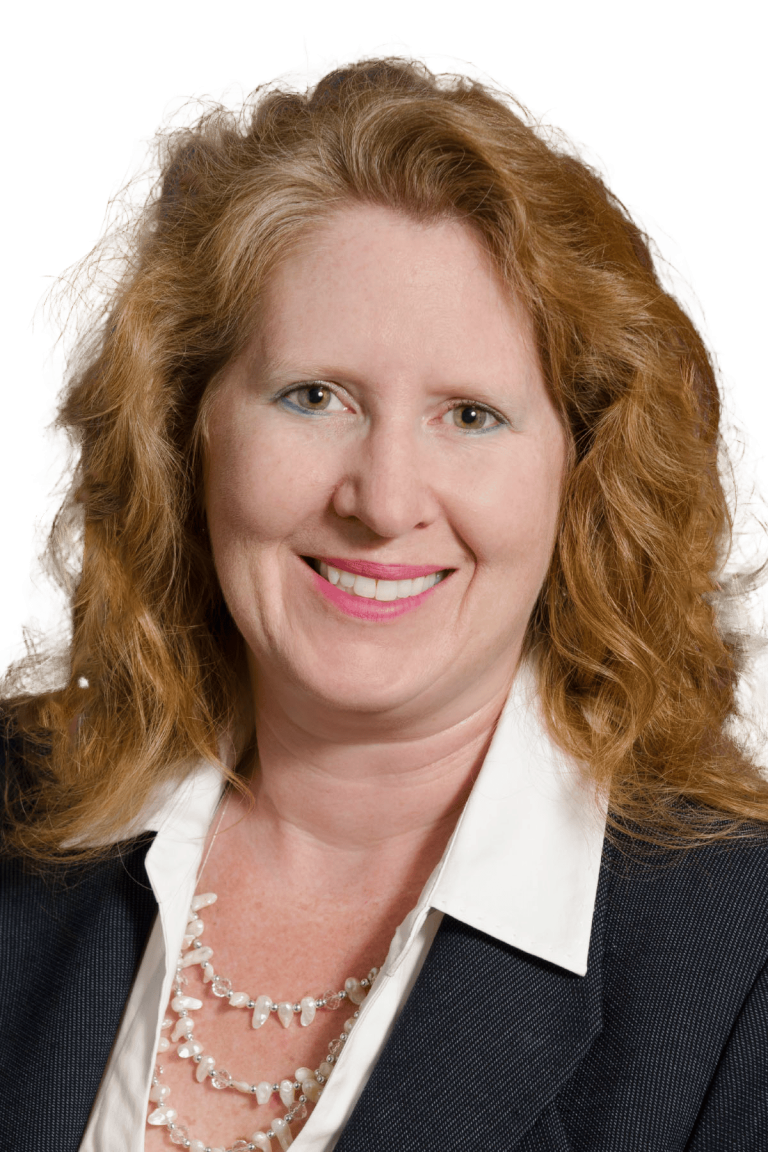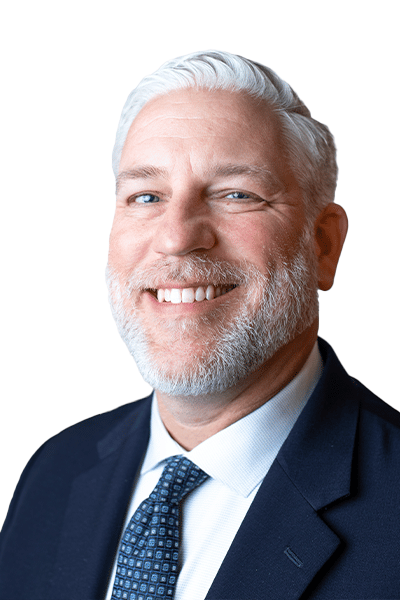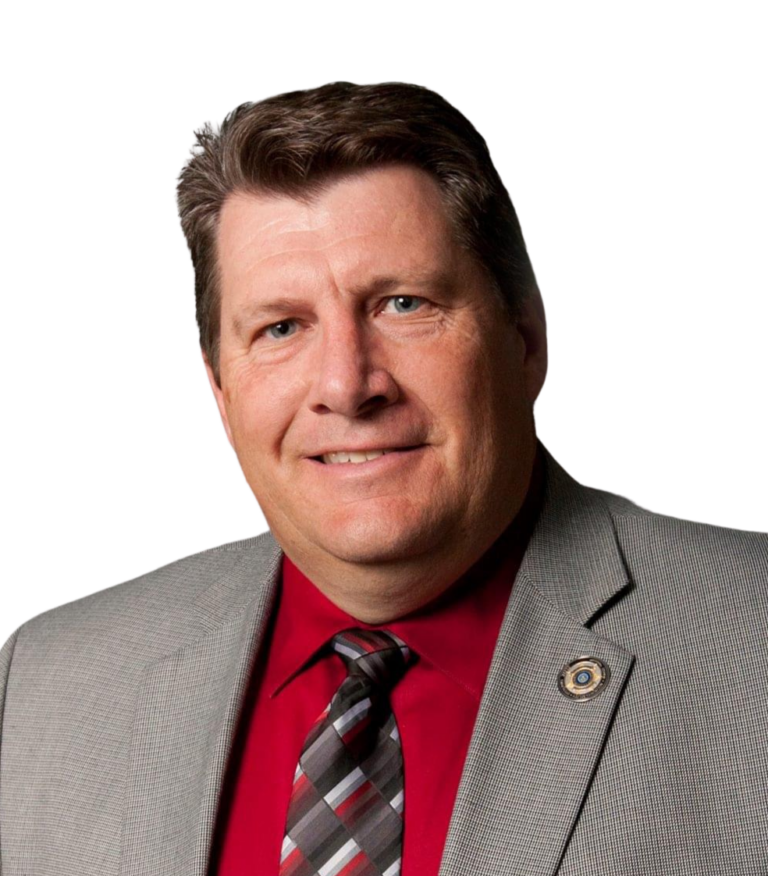
Introduction to Strategic Inmate Management (SIM): A Smarter, Safer Approach to Jail Operations
Incarceration has long been associated with a traditional model of supervision—one that focuses primarily on controlling and containing inmates. But the field of corrections has undergone a significant evolution. Today, correctional professionals and experts are shifting toward a more progressive, proactive approach that not only prioritizes safety but also focuses on rehabilitation, engagement, and human dignity. This approach is called Strategic Inmate Management (SIM).
In this blog post, the first in a multi-part series on SIM, we will dive deep into what SIM is, its evolution, and why it matters. We’ll explore its core principles, how it differs from traditional approaches, and why it’s an essential shift in modern corrections.
We’re joined by Rollin Cook, Brian Lee, and Chloe Jaco, three leading experts in corrections and justice facility management. Rollin and Brian bring decades of experience in correctional operations, leadership, and policy-making, while Chloe brings her expertise in justice facility planning and improving operational strategies. Together, their perspectives highlight the profound impact SIM has had on the correctional industry.
Defining SIM: An Organizational Culture, Not Just a Program
How do you define Strategic Inmate Management (SIM), and what makes it different from traditional approaches to inmate supervision?
Brian Lee: SIM, or Strategic Inmate Management, as it is referred to, was incorporated by the National Institute of Corrections, and it is the process of combining Direct Supervision principles with Inmate Behavior Management. It primarily acts as the umbrella philosophy that allows correctional organizations to incorporate those practices in any type of physical plant. But more simply put, rather than containing inmate behavior and activity with more barriers like glass and steel, SIM is the process of engaging and managing that behavior by providing incentives for appropriate behavior and also by incorporating accountability for people who aren’t acting in the way that they are expected to act in the correctional facility.

Brazos County Sheriff Wayne Dicky recently appeared on the 360 Justice Podcast to discuss the impact implementing SIM has had on his facilities. Hear his thoughts on the importance of meeting the needs of incarcerated individuals and how our assumptions about rule-breaking can hinder effective management.
Why is SIM more than just a management model? Why is it considered a comprehensive operating philosophy?
Chloe Jaco: I was thinking—is the term even correct? Because it’s more about people management, and it’s not just with the in-custody; it’s also with staff. I think a big focus of it is how staff treats each other and even how management leadership interacts with staff and supports and leads by example. The concept is pretty broad. It’s not just about the in-custody, it’s about people in general, and it’s about maneuvering all those relationships.
Brian Lee: You must have the right culture in place to incorporate these practices and these philosophies, and that culture starts with the staff themselves.
Rollin Cook: Sometimes it’s even about changing your mission and your approach to the way you do everything, from the way you manage the facility management piece to the people you’re supervising that are incarcerated, to the people that are working there every single day.

In your view, what’s the most compelling reason correctional facilities should consider adopting SIM today?
Chloe Jaco: Better results in general. Better relationships with the workforce and more supportive and better outcomes for the incarcerated. Bottom line, that’s what I think is the biggest takeaway.
Rollin Cook: Safety and security are something I think we need to make sure rings true out there because the things that we teach people to do – communication, engaging each other, engaging the incarcerated individuals – improve safety and security. All these things we’re talking about also improve staff wellness and their overall well-being. It’s just like in any other business, the way that you treat your employees is the way they’re going to treat the customers, and in this case, the employees are our correctional staff. By approaching things differently and being more positive and proactive, the same thing happens when they start to interact with the incarcerated individuals.
Brian Lee: I just want to underline a word that Chloe used, “outcomes.” I think that’s critical. When I think of my own personal experience with SIM, “outcome” was the driving factor. As a matter of fact, I’ve talked a lot while teaching these philosophies to other organizations. One of the comments that was made to me by a mentor that changed my way of thinking was, “Close your eyes and visualize what you want your facility to look like. Not only look like – sound, smell, feel like – that’s the outcome. Now, once you know what that outcome is, think in the backward sense of how you achieve that.” And I always looked at my desired outcome as, it’s clean, it’s quiet, people aren’t fighting, there are no assaults… it’s a rewarding work environment, it’s respectful. Those are the outcomes. When I work backward to achieving that outcome, the SIM principles just make the most sense to me in achieving that.
The Evolution of SIM: From Direct Supervision and Inmate Behavior Management (IBM)
SIM integrates principles from both Direct Supervision and Inmate Behavior Management. Can you walk us through how those two concepts evolve into what we now call SIM?
Chloe Jaco: SIM is an operating philosophy regardless of the facility type. So often we talk about Direct Supervision or other modes based upon the facility, how it’s designed, or how we’re planning to use it. With SIM, you can do that in any background, any type of facility. It’s more about the way you’re doing things, regardless of the environment.
Rollin Cook: It’s really the best of both worlds. When I started in ‘89, things were very archaic in the way that we managed the population. It was all about simply containing the individual. Direct Supervision came about, and we started to become more proactive and engaging, but that also seemed like most Direct Supervision came with the type of facility design. It was typically dormitory-style or podular, more modern facilities where inmate management was then developed by NIC, which really focused solely on managing the inmate population. There wasn’t a lot of discussion about the totality of how things could operate. The combination of both of those things really allows the positives of each one of these approaches to overlap with each other; and that leads us to an organizational change, an improved culture, and a completely different look at corrections than there ever was before. Just that combination makes a big difference regarding the clean, quiet approach—and its organization-wide.
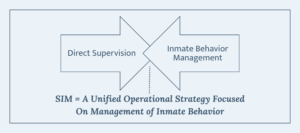
Why is it necessary to develop a unified framework like SIM instead of continuing to treat Direct Supervision and IBM as separate models?
Chloe Jaco: It’s a more realistic approach. Nothing is ever clear-cut. Facilities use different modes of operating based on different times of day, different types of population, different other factors, and SIM cuts through all that. It equalizes a lot of those different variables because it’s still the same approach regardless of all of that.
Rollin Cook: It professionalizes corrections – it’s what we as corrections professionals have wanted to do for so long. It unifies the concepts that we’ve talked about for years about being better communicators and all the leadership training and different things that we give our people but really applies it to our entire facility. Regarding the operations, so often in corrections we get caught up in simply “surviving” every single shift, and this gives us a model that allows us to be more proactive, more thought-out, more engaging – all the things that we would want to be as professionals in the work that we do every day.
Brian Lee: When we look at the current client base that we have across the country, there’s quite a range of different types of facilities, designs, layouts, cultures… I think in general, most of those organizations want to achieve the same thing. When the National Institute of Corrections was looking to solve some of these issues and provide that unified framework… when they developed Direct Supervision, that was developed around a particular design or a floor plan… inmate behavior management also relied on certain aspects… I think they understood that there are important goals everyone hopes and desires to achieve, but people are handcuffed, so to speak, with the type of facilities and the physical plants that they have.
This unified framework brings those principles together. When we teach this stuff, people are often skeptical. After they’ve heard the material and they’ve learned the principles, you hear a lot of people say, “SIM is really ‘Corrections 101’,” and “that takes me back to my early days in corrections, when the line-level staff had authority. They were making those decisions.” It’s really about accountability for those individuals and just bringing that back to where it seems to have wandered away over the years. That’s why it’s necessary for this unified framework. Back to the basics.
Core Elements of SIM: Six Key Pillars

What are the core principles or elements that every agency needs to understand to grasp what SIM really is?
Rollin Cook: SIM is built on six fundamental elements that serve as the pillars of the system. Each of these elements contributes to the overall success of SIM by focusing on engagement, accountability, and respect at all levels of the organization.
1. Assessing Risk: The first one is assessing risk. When someone comes into the facility, it’s important for us to be looking at everything that has led them up to this point. Risk needs assessment that will evaluate how we’re going to manage them; what sort of things are they going to need while they’re with us?
2. Classification: Then it’s the classification piece. It’s assigning people to appropriate housing units and getting the right populations together so that you can work with them in those areas that have been identified for them. Classification ensures that inmates are placed in environments where they are most likely to succeed, minimizing the chances of conflicts and incidents. Proper classification helps to maintain order and stability within the facility, while providing the right programming, education, and rehabilitation to the incarcerated based upon their needs.
3. Meeting Basic Needs: The part that’s often missed is meeting inmates’ basic needs. Understanding Maslow’s hierarchy of needs is very important. Just being reminded that first people need the very basics, which are food and water, those kinds of things. Then they need to feel safe in their environment. These needs must be prioritized to create an environment where inmates feel secure and stable. The next step is providing positive social interactions, which allows them to build self-esteem, which leads to one of the parts that SIM talks about the most, and that’s self-actualization. This is the stage where those who are incarcerated in this positive and productive environment choose to make substantial changes to their lives.

4. Self-Actualization/Individual Accountability: This principle is where those who incarcerated are involved in the way that we manage these facilities— they must be held accountable and have the belief that they can get better, and they can improve. Those are such important things that people often miss. SIM emphasizes holding inmates individually accountable for their actions. Inmates who engage in negative behaviors are held responsible for those actions, not as part of a group but as individuals. This ensures that accountability is clear and that inmates understand the consequences of their actions.
5. Supervising and Leading the Population: The fifth principle is about the importance of having good leadership, which requires leadership training. Effective leadership is crucial in SIM. It requires that the supervisors are leading their people the same way that they’re being trained to lead the incarcerated population—by empowering people and including them in the process. Supervisors must lead by example, empowering their staff and ensuring that they are trained to engage inmates in a positive and professional manner. Leadership at every level must be proactive and supportive, creating an environment where everyone feels involved and valued.m
6. Engaging Inmates: The last principle is keeping inmates busy, providing them opportunities to continue to do something. Because if you don’t, they’re going to spend their time thinking about ways that they can cause trouble for the employees or cause disturbances or inappropriate conduct. Keeping inmates engaged is essential to reducing idle time and preventing negative behaviors. Providing educational programs, work opportunities, recreation, and therapy are key components of SIM. Engaged inmates are less likely to cause problems, and they are more likely to focus on self-improvement.
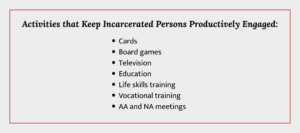
Brian Lee:. I’m glad Rollin brought up Maslow’s hierarchy of needs, because that’s something every human has, and I think we forget that sometimes in a correctional environment. A lot of people who work in correctional environments sometimes think if somebody’s acting out, they’re doing it just to intentionally ruin their day or to do something damaging. When we break these things down into their basic elements, it really starts to make sense. People start to understand, “Maybe there’s another reason why people would act out in this manner, in this behavior.”
Perhaps there’s something that’s not being provided or a condition that exists here that’s causing this behavior, rather than assuming, “Some people are just wired this way.” People certainly have different experiences in their lives that brought them to where they are, but there are things that we can do to make people feel safe, to make sure that they have those basic needs. When they feel secure in those environments, then we can hold that accountability level and develop the type of environments we want. People see that there’s a better way to live. Most of the time, when people act out, it’s out of survival.
Chloe Jaco: I think that’s what’s so great about SIM training. It’s really about awareness and empathy. Somebody does something wrong and instead of going, “I can’t believe you did that,” try more along the lines of, “Oh my goodness, what happened? What made you do that? Why did you do that?” The “why.” That came up a lot during our trainings and teachings. It’s a crucial aspect of the concept of SIM.
Why SIM Matters Today: Addressing the Challenges of Modern Corrections
SIM is built on the assumption that most inmates, when placed in the right environment and given clear expectations, will behave rationally. How does this belief change the way staff and leadership approach their jobs?
Chloe Jaco: It’s about the empowerment and making sure to let first-line officers who are interacting in the units directly within custody to have the ability to address their needs, to be a resource, to be a support. We’ve learned in our training that this goes through even to the job descriptions, such as how you list and describe the job that you want the individual to do – doesn’t matter where in the facility we’re referring to, whether it’s in maintenance or healthcare or the kitchen or the housing officer. It really is putting that human connection spin, that empathy, in how you’re doing things to get better results.
Rollin Cook: The understanding from a leadership standpoint that everyone is important. Everyone adds value. Whatever things we’re teaching the line staff about, you can tell that they’re often encouraged with the understanding that we’re going to be talking to the leadership about this very thing – about how they talk to you and how they approach things; how they empower you to do your job and how they coach you and counsel you. You can feel a sense of appreciation for that from the line staff – understanding that leadership empowering their staff is applied to how we’re expecting them to be leading these large groups of incarcerated individuals – that same type of approach should be done from the leadership levels, as well, being engaged and involved in empowering their employees.
Brian Lee: I call it ‘self-fulfilling prophecy’ when we talk about SIM. We talk about the assumption that most inmates, when placed in the right environment and given clear expectations, will behave – I found that to be true, and I also find self-fulfilling prophecy to be true. When you think about a correctional facility, think about what some of the older correctional facilities look like. Tables and chairs are bolted down. They’re stainless steel, it’s very cold, and it’s very dark, very heavy fixtures and things like that. Why? Because we expect people to try to damage things. We expect people to try to break windows. We expect people to fight. And a lot of times when that’s the environment you create and that’s what you expect, guess what happens? Exactly what you expect to happen.
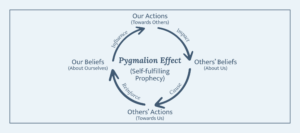
The Pygmalion effect, also known as the Rosenthal effect, is a psychological phenomenon where high expectations from others can lead to improved performance in a given area. Essentially, if someone believes you can achieve more, you’re more likely to do so. This effect is a self-fulfilling prophecy, where positive expectations can create a positive outcome.
When you develop an environment that’s different than that, when there’s an expectation of, “Hey, we expect you to behave and we think you can,” we think most people can behave. Look at some of the newer facilities adopting those philosophies. Things like carpeting, softer furniture, incentives, televisions, contact visitation… A weird thing happens: people act like human beings. Intake facilities used to be a series of holding cells, essentially cages that separate people from each other and separate people from staff. Why is that? Because we assume when people come into custody, they’re violent, they’re dangerous, they’re going to throw things at us; they’re going to assault us. When that’s what you expect, that’s what you get.
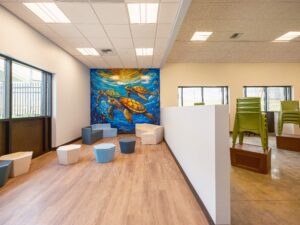
Normative environments, such as those that feature bright colors, daylight, soft furnishings, and artwork or murals, promote positive behavior and support meeting the needs of inmates.
When you see newer intake facilities, you’re starting to see a lot of open holding areas where people are brought in and they’re told from arrival, “We think you can behave. We think you’re having a bad day. We think we’re catching you probably on one of the worst days in your life, and we’re not going to judge you based on that. We’re going to treat you like a human being, and if you behave the way we expect you to, we’ll try to get you in and out of here and make this process as painless as possible.” For law enforcement agencies that are considering adopting these principles, when they stop and really think about it, they begin to understand that they tend to revert to the worst-case scenarios as if that’s what happens all the time. But when you really break it down into these core principles, they start to think, “Yeah, it probably is less than 10% of people that are likely to cause issues, but yet we’re treating all of them with that expectation.”
When you identify the people who are actually violent and who are likely going to act out, and you separate them and treat the rest appropriately, it’s amazing the outcomes you can achieve.
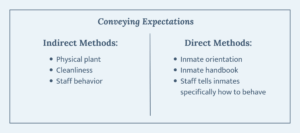
In SIM, it’s important to convey behavior expectations through a balance of both direct and indirect methods.
SIM in Action: Real-World Examples and Powerful Outcomes
Have you encountered situations where shifting that mindset about inmate behavior led to immediate changes and outcomes?
Rollin Cook: I have the personal experience of bringing this type of training to Salt Lake County when we were opening a brand-new, 2,000-bed, state-of-the-art facility. Many of the people who were working there at the time were saying, “I’ll never work in that facility and in that environment.” Then we began this type of training and put them through it and gave them opportunities to learn the new perspectives and how things could be improved.
The very best officers from years ago oftentimes are the very best now because they have those communication abilities. We put them through training and then we even set up a practical application training. We took over a unit and gave everyone the opportunity to work in there for a week, including all supervisors and leadership. They took off their rank and went in and worked a unit and implemented these ideals and these elements to manage the population. When we moved to a new facility, we were ready to go. When we began, NIC told us that we would likely lose about 25% of our employees when you move from an old facility to a brand-new facility. Because of the training, because of us taking the time to put people through the practical piece, holding our leadership accountable and so on, we were able to reduce that to 8%.
That facility today is still visited by people around the world. They come to look at “how are you managing your populations?” And they’re still managing it that way today, so sustainability is there, the success is there regarding managing the population effectively.
Brian Lee: Through the days of that initial SIM administrator training, when you start going through these concepts, you encourage a lot of ‘aha’ moments with these folks. They start thinking through the day of their own thought processes and how they deliver services and how they manage security. That’s the most interesting part of the conversation because it just becomes apparent to people when you break it down in these basic principles. They think, “We can actually create a better outcome just by changing these simple things.” A lot of folks think that it has to do with a floor plan or a new or redesigned facility – it doesn’t. It’s just in your approach and how people are treated in those sets of expectations. It’s rewarding for us, too, to give this training, to help people realize that.
Addressing Challenges: Overcoming Resistance and Skepticism
How do staff and leadership typically respond when first introduced to the principles of SIM? What resistance or skepticism is common, and how is it overcome?
Brian Lee: It’s a mixed bag, a wide range. A lot of times, the administrators are the ones who will bring the implementation of SIM. They see the need to change the way things are being done. Sometimes it’s out of necessity. What we’re seeing a lot here lately is some clients we’re working with are planning for new designs, new facilities, and that sometimes doesn’t pan out. The project itself falls apart, and they’re saying, “We still need to do something differently here, and we’ve learned a lot in this design process, so how do we effectively change without building a new facility?” Really, it is just incorporating the SIM principles, and we see a positive response from people who are asking us for it.
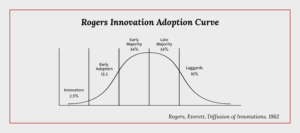
The Rogers Innovation Adoption Curve is a method of explaining how, why, and the rate at which an innovation or idea, such as philosophy like SIM, spreads through a population or social system.
In other cases, we get skepticism – oftentimes a kind of political divide. People think everything’s political these days. They think SIM is too “soft” of an approach. There’s a sense of, “I don’t want to hear it. I’m against it.” Then after they hear the explanation, after they’ve been through the training and received the materials, they think much differently about it.
It’s a wide range of responses from very welcoming to very negative, and it’s usually the higher-ranking staff who are more welcoming of it as far as the administration. But that’s even changing now. Let’s talk about three categories: you have your administration, then you have your entry-level people who haven’t been around for a long time, and then you have everybody else in the middle. What I’m starting to see now is your entry-level people are way more supportive and excited about this because they’re not married to a particular way of doing things. You always hear when you’re bringing training to an organization, “Oh, these younger people now, they don’t understand, they don’t get it.” Well, that can be a huge benefit when you’re incorporating these changes because they’re not married to a particular way of doing things. People fresh out of college, high school, whichever, they understand these concepts more than we understand that they believe in them. Usually, the biggest resistance you get is from that middle group of people that have maybe been around for 10, 15, 20, 25 years. Change is hard. Change is hard for everybody, and maybe in some cases, they even believe it or understand the need for it, but the change itself is just very difficult for them to overcome.
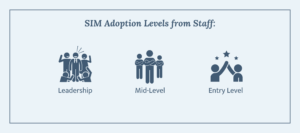
Successful SIM adoption requires participation from all levels so it is important to adapt to varying responses to change.
Chloe Jaco: Another group to add to that is the jurisdictional leadership. Often, it does have some good support at the highest level, like commissioners or executives or managers. We certainly have seen that with counties we’re working with, where they’ve got a lot of support because of the community and the outcomes they want, and working with volunteers and different organizations. They see this as a very positive way to bring all that integration and collaboration together.
Brian Lee: We get a lot of support from that level because a majority of the time, those decision-makers as elected officials are looking for a different way of doing things. They recognize a particular way of doing things for so many years hasn’t gotten us as a society to where we want to be or where we need to be.
SIM and Facility Design: The Role of Environment
How does the physical design of a facility support or sometimes complicate the implementation of SIM?
Chloe Jaco: We all know an older design can pretty much impact anything you’re trying to do, but I think that is the beauty of SIM. If you’re really working the model, like you should, you can overcome some of the physical challenges. You’re still going to have some challenges with certain older facilities in that it may alter the way you go about doing your practices, but I feel more hopeful that some of this can be overcome the more I learn and teach about SIM.

Rollin Cook: The great part about it, it’s not just a Direct Supervision model. It doesn’t have to be utilized in a dormitory-style or a Direct Supervision facility. The concepts we talk about in SIM apply anywhere that you’re working in corrections because it’s about how you speak to people. It’s about being proactive and engaging them. You do that regardless of whether you’re in a linear-style facility or a podular-style facility or even in those that are run down. The very best officers are up walking around, and those who are incarcerated know who those staff are, who those employees are. What we teach applies in all those facilities because it’s the way you communicate and the way that you work with people.
SIM really provides a light. Those of us who have been in corrections a long time know it often just feels dark, dirty, and negative. It can feel like we’re reactive all the time. The SIM model works in facilities that are like that, and I think it does it by providing some light, by engaging those that are already working there, gaining their firsthand experiences as examples where an officer has made a difference in the way that they communicated or the way that they managed a certain situation.
Chloe Jaco: And you feel it. You feel it when you walk into a facility. You can walk into a facility that is 150 years old, but if everybody is working like this, you’ll feel its positive energy.
Brian Lee: I recently had a very unique and rewarding experience in this area. I was teaching a SIM administrator role training to an agency for which I had been a part of the planning and design of a new facility they’re working on. Throughout that design process, I worked to convince the agency to work towards a more open intake area design – again, one that assumes that 90% of inmates can behave when they’re given those expectations, when they’re treated a certain way. That conversation was always a challenge because the agency themselves thought intake is a very volatile time of the law enforcement process. “We don’t know who these individuals are; they can’t be trusted; they’re withdrawing from drugs and alcohol; they’re under the influence…” all of these things.
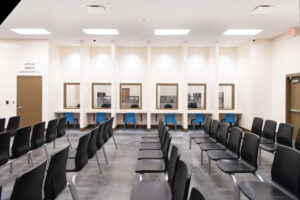
An open design approach to intake aligns with the core principles of SIM.
I went two years being a part of that design process, trying to convince them otherwise, and then recently spent a week with the agency talking about SIM principles and concepts. A week or two later, I’m sitting in the next design meeting with that same group of people that I just taught SIM to, when the architect brought up the design of intake. The warden looked up and said, “What is this? Is this the design we came up with? This is terrible. How did we come to this conclusion? All of these closed-in holding tanks.” The warden said, “What are people in those holding tanks focusing on when we contain them like that? Look at the way they’re facing each other. What do we think is going to happen?”
Within two hours of that design meeting, I saw the warden say, “Open up all of those holding tanks. We want open waiting. We want to be able to see and hear these people and engage with them.” Two hours after a week-long SIM training they reached this pivotal ‘aha’ moment – something I couldn’t achieve in two years of discussions and design concepts. That was the most rewarding process I’ve ever seen in SIM. It was just cool to watch.
Everything goes back to culture. When you have the right culture in place and people understand that mindset and they understand the foundation of SIM, the facility itself plays a small part in that. It certainly makes things challenging because when you look at these older-style facilities designed in the seventies and eighties, they’re very compartmentalized, and so it becomes a staffing problem. How do we get staff into all those individual compartments? We just don’t have the staff for that. That’s always a challenge, but that does not take away from the fact that you can still implement the principles of SIM. You can create expectations, individual accountability, and meet basic needs.
Stay Tuned to Learn More
Strategic Inmate Management (SIM) is far more than just a program. It’s a transformative organizational philosophy that has the potential to change the future of corrections. By emphasizing proactive engagement, individual accountability, and respect, SIM creates environments where both staff and inmates can thrive.
Stay tuned for the next installment in this series, where we’ll dive into how to make the shift to SIM in your own facility. We’ll cover how to prepare your staff, implement new strategies, and overcome common challenges when transitioning to SIM. The future of corrections is being shaped by SIM, and it’s leading the way toward smarter, safer, and more effective jail operations.
